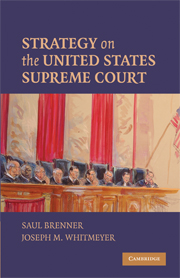Book contents
- Frontmatter
- Contents
- Preface
- PART I INTRODUCTION
- PART II CERTIORARI
- PART III THE CONFERENCE VOTE ON THE MERITS
- 6 Strategic Voting at the Conference Vote
- 7 Fluidity and Strategic Voting
- PART IV THE MAJORITY OPINION AND OTHER OPINIONS
- PART V THE FINAL VOTE ON THE MERITS
- PART VI CONCLUDING CHAPTERS
- Appendix 1 Decision Making on the United States Supreme Court
- Appendix 2 Additional Questions to Explore
- References
- Table of Cases
- Index
6 - Strategic Voting at the Conference Vote
Published online by Cambridge University Press: 05 June 2012
- Frontmatter
- Contents
- Preface
- PART I INTRODUCTION
- PART II CERTIORARI
- PART III THE CONFERENCE VOTE ON THE MERITS
- 6 Strategic Voting at the Conference Vote
- 7 Fluidity and Strategic Voting
- PART IV THE MAJORITY OPINION AND OTHER OPINIONS
- PART V THE FINAL VOTE ON THE MERITS
- PART VI CONCLUDING CHAPTERS
- Appendix 1 Decision Making on the United States Supreme Court
- Appendix 2 Additional Questions to Explore
- References
- Table of Cases
- Index
Summary
For most of the Court's history, the justices used a two-stage procedure at the conference vote on the merits. In the first stage, the justices discussed the case and did so in order of seniority, with the chief justice speaking first. In the second stage, they voted and did so in the order of juniority, with the chief justice voting last. This procedure was ideal from the perspective of the chief justice. In the first stage he was in a good strategic position to persuade his colleagues how to view the case. In the second stage, he was ideally situated to vote with the majority if he so wished and, thereby, to assign the majority opinion. Chief Justice Hughes, for example, took advantage of this two-stage procedure (Dickson, 2001, p. 12). During the later years on the Warren Court, this procedure changed (Murphy, Pritchett, Epstein, and Knight, 2006, p. 633). The two stages were merged into one, and the justices both discussed the case and cast their votes in order of seniority, with the chief justice discussing and voting first.
Chief Justice Warren Burger, who came to the Court in 1969, was stuck with the new procedure. Yet he wanted to assign the majority opinion more often and was burdened with voting first. To solve this problem, Chief Justice Burger, at times, “passed” at his initial conference vote and voted with majority after all the other justices had voted.
- Type
- Chapter
- Information
- Strategy on the United States Supreme Court , pp. 53 - 58Publisher: Cambridge University PressPrint publication year: 2009



